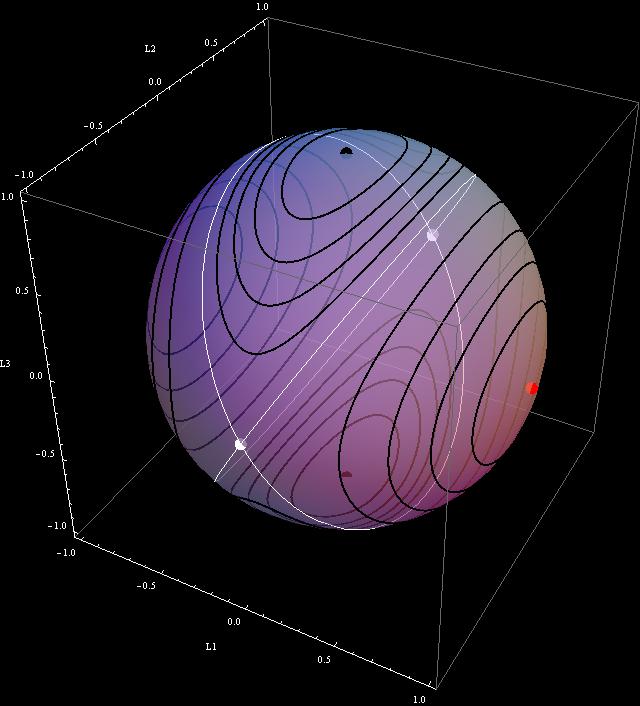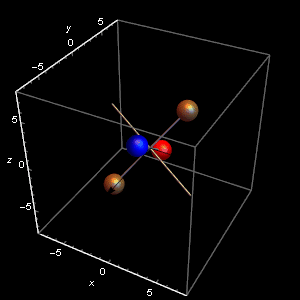I know: my blog is somewhat chaotic. But what is chaos? From “Celestial Mechanics: The Waltz of the Planets” by Alessandra Celletti and Ettore Perozzi:
Chaos From the Greek Χάος, denoting primordial emptiness. The term is used to indicate the extreme sensitivity of a trajectory to the initial conditions, which implies unpredictable dynamical behaviour in the corresponding dynamical system.
With T-handle floating in space and flipping for no apparent reason – it looks like we are in a chaotic mode:
But are we? Where is “the extreme sensitivity of a trajectory to the initial conditions“? We have to address this question. The waltz of planets can be, in some respect, chaotic. But sometimes it is well organized. Like this waltz:
1,2,3 and 1,2,3, and my T-handle that replicates the cosmic behavior in the Dzhanibekov effect (see my previous posts) has principal moments of inertia 1,2,3. Why? What 1,2,3 has to do with chaos?
Time to explain. In general, when moons and planet spin, their motion is not chaotic. But sometimes it can be. Let us take my T-handle with principal moments of inertia ![]() (see my previous post).
(see my previous post).

Spin it about its shorter axis. It may show the strange flipping behavior – see the animated gif below (click to open it)

The “extreme sensitivity of a trajectory to the initial conditions” happens when the parameter ![]() , that is the ratio of the doubled kinetic energy to squared angular momentum vector, is close to
, that is the ratio of the doubled kinetic energy to squared angular momentum vector, is close to ![]() The motion is governed by Jacobi elliptic functions
The motion is governed by Jacobi elliptic functions ![]() The period
The period ![]() of these functions directly affects the time spent by the T-handle between flips. And this period is a very sensitive function of
of these functions directly affects the time spent by the T-handle between flips. And this period is a very sensitive function of ![]() , when
, when ![]() is close to
is close to ![]()
Here is the graph of ![]() for our T-handle:
for our T-handle:

The formula for ![]() involves elliptic
involves elliptic ![]() function. But for
function. But for ![]() very close to
very close to ![]() there is an approximate (asymptotic) formula derived in the paper “Janibekov’s effect and the laws of mechanics” by A.G. Petrov and S. E. Volodin, Doklady Physics}, 58(8):349–353, 2013:
there is an approximate (asymptotic) formula derived in the paper “Janibekov’s effect and the laws of mechanics” by A.G. Petrov and S. E. Volodin, Doklady Physics}, 58(8):349–353, 2013:
![]()
where
![]()
Here is how the two formulas compare:

The blue curve is the simple asymptotic formula.
But why 1,2,3?
Why? Because 1,2,3 is optimal. But what is optimal?
How do we know if 9 to 5 is the most optimal time to work? – Quora
We don’t and we never will know, because everyone is different.
So, what did I optimize to get my 1,2,3? First I had a vague feeling that this is good
Genesis 1:31 God saw all that he had made, and it was very good …
But then I was able to prove that it was good by optimizing ![]() The dimensionless parameter
The dimensionless parameter ![]() tells us how close we are to the critical value of
tells us how close we are to the critical value of ![]() Being very close, near the peak in the graphs above, we want to know what should be the values of
Being very close, near the peak in the graphs above, we want to know what should be the values of ![]() for which the period
for which the period ![]() is maximal? We use the approximate formula above. To find where is the maximum of
is maximal? We use the approximate formula above. To find where is the maximum of ![]() with
with ![]() fixed, is to find where is the minimum of the ratio:
fixed, is to find where is the minimum of the ratio:
![]()
Here ![]() cannot be completely arbitrary. The moments of inertia should satisfy the inequality
cannot be completely arbitrary. The moments of inertia should satisfy the inequality ![]() Suppose
Suppose ![]() What should be
What should be ![]() ? I used Mathematica to get the answer:
? I used Mathematica to get the answer:

If I assume that ![]() then
then ![]() If I assume that
If I assume that ![]() then
then ![]() Simple?
Simple?
So, even if everyone is different, even if there is no optimal answer that would satisfy everybody, there is an optimal answer to my needs, and that is 1,2,3.
“In trying to please all, he had pleased none.”
― Aesop, Aesop’s Fables
With 1,2,3 we have more time to see the butterfly flying. By flipping its wings it can change dramatically the period of the flying T-handle on the other side of the planet.












